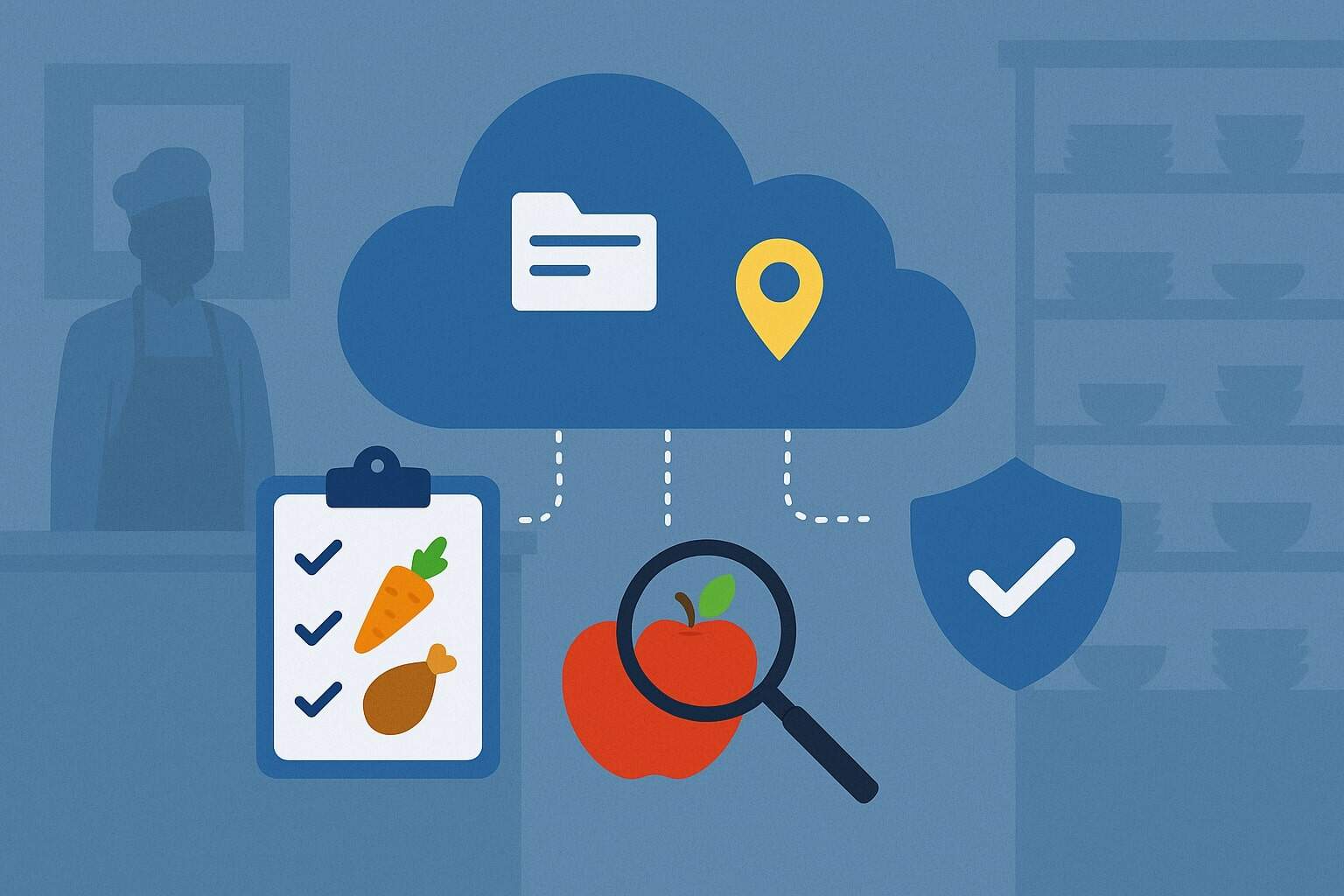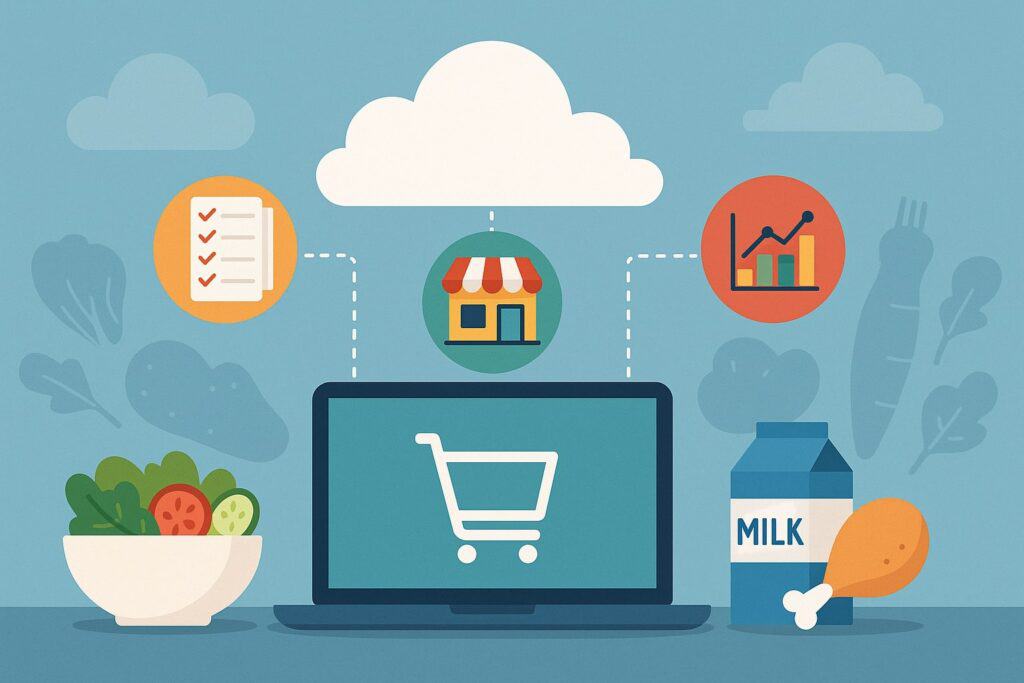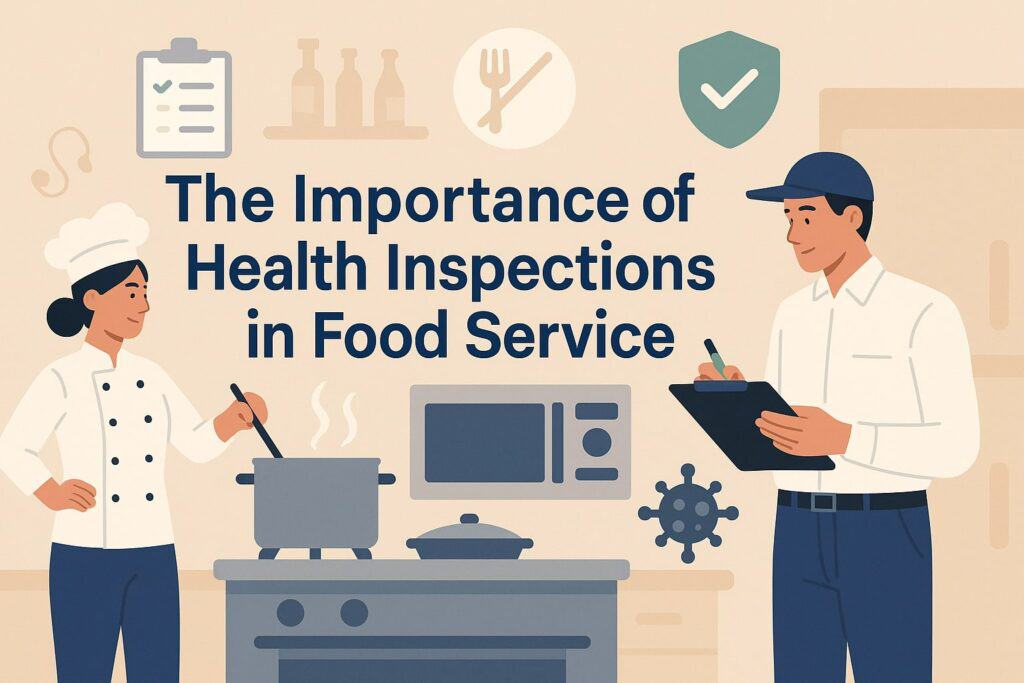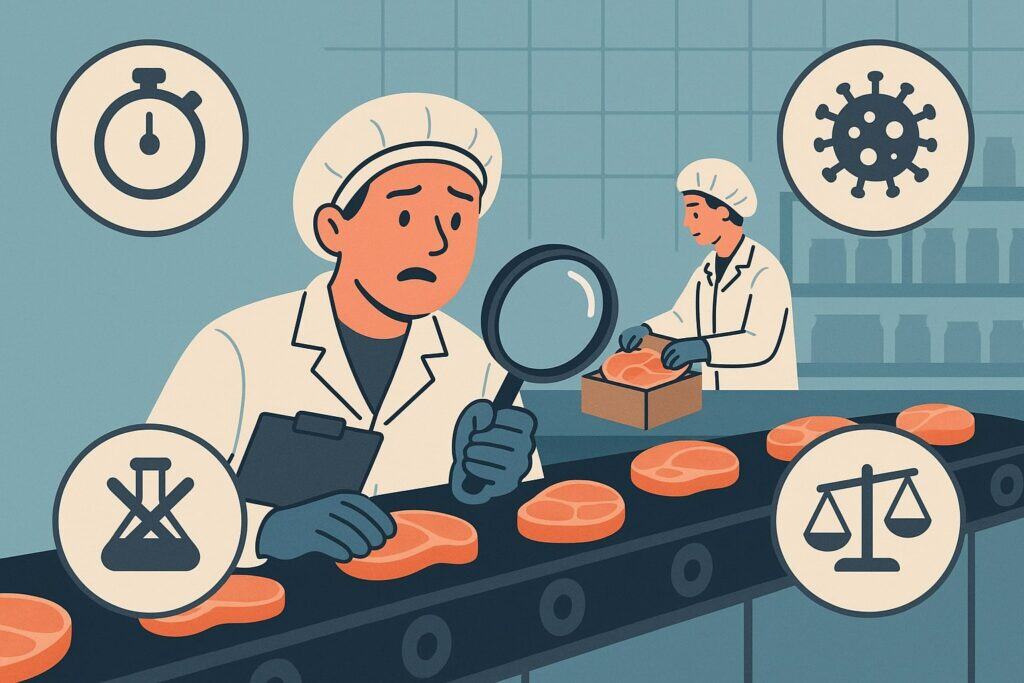
By cloudfoodmanager October 9, 2025
Cloud-based food management systems are transforming how restaurants and food businesses handle safety compliance. These platforms move critical food safety tasks into the cloud, offering digital tools for temperature tracking, checklists, documentation, and analytics.
By replacing paper logs and manual processes, cloud food management software helps businesses maintain up-to-date records and standardized procedures across all locations.
With features like real-time sensor monitoring, automated alerts, and mobile apps, these systems ensure restaurants meet U.S. health department standards and regulatory requirements (such as FDA, HACCP, and FSMA) more easily.
In essence, cloud food management centralizes food safety data and automates routine tasks so operators can focus on serving quality food, confident that they are “always ready” for inspections.
Understanding Cloud Food Management Systems

Cloud food management refers to software-as-a-service platforms that handle food safety and operations via internet-hosted applications. Instead of relying on local servers or paper charts, all data – from temperature logs to cleaning schedules – is stored securely in the cloud.
Users can access the system anywhere (via web or mobile), making collaboration and oversight much easier. These systems often integrate with hardware (like wireless temperature sensors) and other business tools (inventory or POS systems), creating a unified digital ecosystem.
For example, Jolt offers a cloud platform for restaurants that includes digital checklists, sensor integrations, and even label printing for food tracking. Likewise, FoodLogiQ provides cloud-based supply chain management and traceability, helping businesses align with FSMA and other regulations.
Such solutions eliminate paper and spreadsheets, reduce human error, and make it simpler to update processes as regulations or menus change.
In summary, cloud food management software replaces fragmented, manual practices with centralized, automated systems that keep food safety data organized, traceable, and readily available for any health or quality audit.
The Importance of Health Inspections in Food Service

Health inspections are critical to public safety and a restaurant’s legal operation. In the U.S., local and state health departments routinely inspect restaurants and food facilities to check for compliance with sanitation and safety codes (like FDA’s Food Code and HACCP principles).
Passing these inspections is mandatory to stay open; failure can result in violations, fines, or even closure. Beyond regulations, consumers trust that food businesses meet strict safety standards.
For owners and managers, inspections represent both a compliance challenge and an opportunity to demonstrate commitment to food quality. As one industry resource notes, maintaining compliance “is a legal requirement for staying open,” since food safety rules (local and federal) must be met across all U.S. jurisdictions.
Being prepared for inspections also protects reputation and avoids costly health code violations. For example, failing an inspection can mean expensive corrections or lost business, while consistent compliance builds customer trust.
Therefore, restaurants view health inspections as a key part of operations; anything that streamlines compliance (like cloud food safety systems) can directly support success during these audits.
Challenges with Traditional Food Safety Methods

Without cloud tools, many food businesses rely on manual, paper-based systems to manage safety – a method fraught with pitfalls. Common challenges include inconsistent record-keeping, lost or damaged logs, and human error.
For instance, employees may forget to log refrigerator temperatures or fill out checklists, and handwritten logs can be illegible or incomplete. If an inspector appears unannounced, missing or sloppy records can lead to violations and fines.
Multi-location chains face even larger hurdles: ensuring every site follows the same protocols and has up-to-date documents is difficult without a centralized system. Moreover, staying current with evolving food safety regulations (FDA, state codes, FSMA, etc.) often means constantly updating procedures – a headache for busy staff.
The complexity of the regulatory landscape is underscored by the variation among U.S. states; as one guide explains, “federal laws offer an overall framework,” but local rules differ, creating a “patchwork of laws” that restaurants must navigate.
In summary, traditional methods make compliance labor-intensive, error-prone, and hard to scale. This is where cloud food management provides relief, automating tasks and ensuring nothing important slips through the cracks.
Key Benefits of Cloud Food Management for Health Inspections
Cloud food management systems address the challenges above by providing automated, reliable compliance tools. The following benefits directly help restaurants streamline health inspections:
- Digital Records and Audit-Ready Documentation: Instead of paper charts, logs are stored in the cloud, time-stamped, and searchable. Managers and inspectors can instantly retrieve any temperature log, cleaning checklist, or training record.
As one review notes, digital forms allow you to “quickly document health inspections and track food safety compliance,” eliminating messy paperwork and raising standards across teams.
Centralized document management ensures all compliance records are accurate and easily shareable; this means when an inspector arrives, the evidence of correct procedures is immediately at hand. - Real-Time Sensor Monitoring: Modern systems integrate with wireless sensors for 24/7 monitoring of conditions in walk-in coolers, freezers, and warmers. If temperatures stray outside safe zones, the system sends instant alerts via text or email. This proactive monitoring prevents food safety breaches before inspectors notice.
For example, Swift Sensors explains that placing IoT sensors in refrigerators “continuously track temperatures and send data to a secure cloud dashboard,” ensuring teams can act before a violation occurs.
Automated logging of these readings means “digital records that are always accurate, time-stamped, and inspector-ready”, giving restaurants peace of mind that their logs will pass scrutiny. - Automated Checklists and Task Reminders: Daily tasks like opening/closing checks, equipment sanitization, and handwashing audits can be automated. Cloud software replaces static paper checklists with interactive digital checklists that staff complete on tablets or phones.
Managers can assign tasks, set schedules, and get notified if something is missed. RestaurantHQ highlights that “daily opening, closing, and cleaning checklists” are vital, and automation guides staff through each step consistently.
By standardizing these processes, every location meets the same standards, and nothing (e.g. an ingredient swap or unusual procedure) slips through. Plus, automated alerts mean teams don’t forget tasks—shifting focus “from reactive damage control to proactive prevention,” as ongoing monitoring and alerts keep the operation continuously compliant. - Training & Accountability: Health inspections often look at staff training and adherence to protocols. Cloud platforms typically include employee training logs, quizzes, and performance tracking.
For example, Jolt’s system includes quizzes and an information library so owners can ensure staff understand food safety steps. Cloud systems also log which employee completed each checklist, adding accountability.
This makes it clear who performed tasks and whether all workers are up-to-date on procedures. The result is a more knowledgeable team and evidence that staff are trained—an important part of passing inspections.
As one source notes, transforming food safety into “part of everyone’s job” empowers staff to catch hazards early. - Traceability and Ingredient Labels: Some cloud systems include features for ingredient tracking. For example, Jolt offers a label-maker that prints date and batch information on food packages.
Keeping ingredients clearly labeled with preparation and expiration dates prevents spoilage and helps inspectors verify that food is fresh. On a larger scale, supply-chain-focused platforms like FoodLogiQ provide traceability from farm to fork, ensuring quick responses to recalls or contamination events.
In essence, digital traceability gives both regulatory agencies and business owners detailed provenance of ingredients, simplifying investigation and demonstrating compliance.
Overall, these benefits add up to a restaurant that is always ready for an inspection. Automated logging and digital records mean nothing is left untracked. If auditors ask for proof, everything is already documented and retrievable.
As MyFieldAudits summarizes, cloud-based food safety software helps maintain “accurate records and documentation required for inspections,” giving business owners confidence that they meet the standards.
Leading Cloud Food Management Platforms
Several cloud food management platforms are popular in the U.S. restaurant industry, each with unique features:
- Jolt: A widely used operations and food safety platform, Jolt provides restaurant managers with digital checklists, remote temperature monitoring, and labeling tools.
Its cloud-based system helps operators “pass inspections automatically, every time,” by simplifying tasks like temperature logs and date-labeling.
For example, Jolt’s sensors notify staff of any temperature excursions, protecting inventory and ensuring food safety. Chains like Zaxby’s and Dairy Queen report improved inspection scores after using Jolt.
In short, Jolt focuses on day-to-day compliance – digital record-keeping, alerts, and employee accountability – making health inspections less stressful for restaurant owners. - FoodLogiQ (by Trustwell): While FoodLogiQ serves food manufacturers and suppliers, it offers cloud traceability and compliance tools that benefit restaurant chains as well. Its suite includes modules for supplier compliance, traceability, and recall management.
FoodLogiQ’s cloud platform gives companies “a full view of your supply chain,” ensuring they are “always ahead, prepared, compliant, and ready for anything”.
This means that if a restaurant sources produce from various farms, FoodLogiQ can track ingredient origins and safety audits centrally. In terms of inspections, FoodLogiQ’s focus on regulatory alignment means organizations can approach audits worry-free, with all data organized in the cloud. - Xenia: Xenia is an AI-powered operations platform designed for restaurants. It automates inspection processes by generating smart checklists and using AI to analyze audit results.
According to product documentation, Xenia offers “ready-to-use templates that comply with HACCP, OSHA, and FSMA” standards, and it uses AI to streamline audit preparation and findings.
In practice, Xenia helps managers stay ahead of health inspections by continuously updating checklists to match regulatory requirements and by summarizing data for quick review. Its goal is to reduce the burden of compliance through intelligence and automation. - Other Cloud Solutions: Beyond these, there are many software options. MyFieldAudits delivers custom inspection programs and handles end-to-end audit management.
FreshCheq provides a mobile-friendly food safety solution focused on checklists and alerts for smaller businesses. FoodDocs offers a smart app with HACCP templates and real-time dashboards. While features vary, all these systems emphasize cloud access, digital logs, and automation.
RestaurantHQ notes common features to look for: digital HACCP logs, mobile apps with offline mode, custom SOP templates, and automated alerts for inspection prep.
Ultimately, each platform aims to simplify the food safety workflow so that restaurants can consistently pass health inspections without relying on paper trails.
Future Trends in Food Safety and Inspections
Emerging technologies are enhancing how cloud food management supports inspections. IoT sensors are becoming ubiquitous, as seen with wireless monitors for temperature, humidity, and even door openings.
Future systems will expand sensor networks for even finer real-time control (for example, UV indicators for sanitation or smart cameras to detect handwashing).
Artificial Intelligence and machine learning will play bigger roles: some platforms already use AI to generate audit forms and flag anomalies. As more data is collected in the cloud, predictive analytics could warn managers of risk patterns (e.g. a fridge that tends to spike at certain times).
Blockchain and traceability are gaining attention too. Cloud platforms may increasingly incorporate blockchain ledgers to provide tamper-proof records of food origin and handling, greatly speeding up any contamination investigations.
Moreover, integration between cloud food management and other systems (like point-of-sale, inventory, or delivery apps) will streamline operations. For example, a sale logged on the POS could automatically decrement inventory and log it in the safety system, ensuring constant alignment.
All these trends point to a future where passing a health inspection becomes largely a matter of maintaining well-designed digital workflows and continuous monitoring. Businesses that adopt these cloud solutions will likely see fewer surprises and greater confidence during audits.
Frequently Asked Questions
Q: What is a cloud food management system?
A: It’s a software platform hosted online that helps food businesses manage safety compliance and operations. All data (checklists, logs, menus, etc.) is stored in the cloud, so it can be accessed from any device.
These systems often include features like digital HACCP logs, temperature monitoring, employee scheduling, and reporting. Because they run on the internet (SaaS), there’s no need for in-house servers or paper files.
Q: How does cloud food management help with health inspections?
A: Cloud systems automate and digitize many inspection-related tasks. They provide real-time data and records for inspectors to review. For example, temperature readings are logged automatically, checklists are completed on tablets, and training records are up-to-date.
This means when an inspector arrives, you can instantly show accurate, time-stamped records of all procedures. It greatly reduces the chance of missing a log or having incomplete paperwork.
Q: Are cloud food management systems only for large chains?
A: No. While big chains benefit from multi-location features, many cloud solutions offer scalable pricing and mobile apps suited for small restaurants or single-location cafes. Even a small team can use smartphone apps or tablets for daily tasks.
Cloud software can be surprisingly affordable (some even have free tiers or low-cost plans) and can grow with the business.
Q: Is data on these systems secure?
A: Reputable cloud food management providers use encryption and secure hosting (often with certifications) to protect data. Since they serve food businesses with strict regulations, they prioritize security.
Most allow role-based access so sensitive info is only seen by authorized staff. In fact, cloud systems can be more secure than paper records, which can be lost or viewed by the wrong people.
Q: Do these systems comply with FDA or FSMA rules?
A: Yes, many are designed with regulatory compliance in mind. For example, platforms often include HACCP templates and FSMA-aligned workflows. FoodLogiQ explicitly focuses on FSMA traceability and supplier compliance.
Systems like Xenia and MyFieldAudits update their content to match FDA, USDA, or local health codes. Ultimately, while the software helps organize compliance, the business is still responsible for meeting all relevant laws.
Q: How do I start using a cloud food management system?
A: First, identify your needs (audit preparation, temp monitoring, SOP management, etc.). Then research solutions like Jolt, FoodLogiQ, Xenia, or others to find one that fits your budget and requirements. Most offer demos or free trials.
Implementation typically involves digitizing your existing logs and schedules into the system. Many providers offer onboarding support. Once set up, staff can start using phones or tablets to complete tasks, and managers can review reports in real time.
Conclusion
Cloud food management systems empower restaurants and food businesses to meet and exceed health inspection requirements with greater ease. By moving food safety processes into the cloud, these platforms deliver accurate digital records, real-time monitoring, and automated compliance checklists.
This means fewer compliance headaches and a consistent track record of passing inspections. In an industry where regulations vary and consumer safety is paramount, having all data organized in one place is a game-changer.
As technology evolves, early adopters of cloud food safety software will benefit from smarter insights and smoother inspections. In short, cloud-based food management makes it simpler to stay compliant, protect customers, and run a successful operation – even under the scrutiny of the toughest health inspectors.